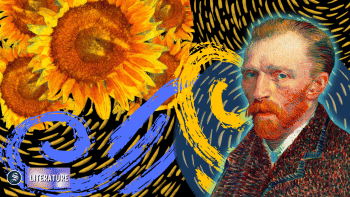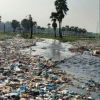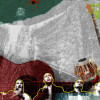The great Padma story

In his introduction, the editor, architect and author Kazi Khaleed Ashraf, rightly and ruefully observes that there has been a plethora of studies on the Ganges with the emphasis almost always on where and how it begins (in the abode of the Gods), not where and how it ends (in the realm of men), as it empties itself into the Bay as the Padma.
This substantively rich and handsomely produced volume relating to the complex and multi-dimensional phenomenon that this river represents, is a very comprehensive and authoritative corrective to that inexplicable neglect. In various chapters the book traces its historical, hydro-geological, and habitational context, and indicates its role in defining our identity, tastes, struggles, despairs, illusions and joys.
The Padma had always been saddled with a mild inferiority complex. Though derived from the same source, it was denied the maternal status, the sacral aura, the veneration typically reserved for the storied, mythicized and worshipped Ganges. In his enlightened and elegant early chapter Ashraf describes how, through a quirk of fate and nature, the Ganges bifurcated with the Hooghly-Bhaghirathi draining off in one direction and the Padma continuing into today's Bangladesh as another.
But shorn of its sacred grandeur the Padma has embraced its secularised and earthier image with some muscularity, audacity and flair. The "mohonas" (meeting points) where it combines with the Brahmaputra/Jamuna and later the Meghna in romantic and raucous exuberance, make the river almost "oceanic" in its scope, and create a river system that is not just mighty and heroic, but almost epic in its scale, consequences and contradictions (simultaneously "sarbo-nasha" i.e. destroyer, and "jibondatri" i.e. life giver).
The "Padma process", skillfully delineated by Arfar Razi and Sanjoy Roy, or the "Padma dynamic", perceptively explicated by Iftekar Iqbal, describe how the river has contributed to creating a restless, teeming, unique terrain of the largest and most populous delta in the world, not only as integral to this "ecological regime", but also a dominant player in the region's formation, structure and evolution.

It is also part of the creative magic and madness that great rivers such as the Nile, Mississippi, Amazon, Volga, Rhine, Danube, Mekong or the Thames, usually evoke. Who can read Tennyson's "The Brook", Langston Hughes' "The Negro Speaks of Rivers", or TS Eliot's "Dry Salvages"; who can pick up Alex Moorehead's The White Nile, David Duncan's The River Why, Joseph Conrad's The Heart of Darkness (where the unnamed river is almost certainly the Congo), Mikhail Sholokov's And Quiet Flows the Don, or pick up Mark Twain (who derived his pen-name from the diction of Mississippi boatmen), without thinking of the significance of rivers in our literary landscapes?
The Padma is no exception. Dipen Bhattacharya alludes to it, Arijit Chatterjee analyses its influence on Tagore often living on the Padma in the Padma (which is what his river-boat was called), and Manzurul Islam's characteristically informed and insightful essay traces the river's long and lingering shadow on Bangla literary productions.
There are also pieces on the river's role in cinematic classics such as Jago Hua Savera and Padma Nadir Majhi, on the architectural innovations demanded by the challenges of "Inhabiting Wetness" (as Marina Tabassum calls it), and Yves Marre has a charming contribution on the variety of boats that ply on the river and the gradual evolution of their shapes, sizes and colours.
But rivers are not merely to be romanticised, glamorised and spiritualized. There are several charming chapters on, what Redfield calls, the "little traditions" reflecting the lived experience of the people. There is one on the iconic ilish, the fish that is the culinary jewel in the crown of Bengali cuisine, another on the distinctive fowl curry and other delights found on the commercial hubs dotting the riverbanks, and one on the delectable sweetmeats unique to the region.
Some aspects of recent transformation are addressed in several superb articles on the mechanics of the construction of the Padma Bridge, and its challenges, meaning and impact on the region. There is also an educational (though essentially descriptive) segment on the evolution of 14 human settlements along the river.
The sheer range of the book, its scholarly content, the stunning pictures and the rare and fascinating maps, are all quite remarkable. However, there are probably some "absences" that are intriguing. Four may be mentioned in a supportive spirit.
First, when we see Van Gogh's Starry Night over the Rhone, or Matisse's Bathers by a River, or Monet's La Grenouillere; or listen to Strauss' Blue Danube, Smetena's Vltava, or the Delta Blues of Black musicians in Southern US, we appreciate this relationship between rivers and the arts. The delta has also been reflected in the works of Zainul Abedin, Sultan, Qayyum Chowdhury and Alokesh Ghosh, or the music of the Baul, Bhatiyali, Bhawaiya, and Jari traditions, which are mentioned in Ashraf's essay, but could probably claim more exclusive focus.
Second, there are political issues relating to hydro-hegemony and water-sharing which have left lower riparian countries like Bangladesh in vulnerable situations, and increasingly awkward. There are also the dangers of ecological violence in the service of predatory capitalism (both internally through pollution, deforestation, sand-lifting, river dredging, hill cutting and so on, and externally through the dynamics of climate change), which threaten the character, if not the very survival, of the delta in its current form. Additionally, there are questions of river basin management and flood control vital to the lives of the people.
Third, there are issues of historical sociology in the context of the new lands created by the silts and shifts of the river flows, which invited new migrants to settle, and necessitated different, more open and inclusive, structural arrangements and community attitudes. Richard Eaton, Akbar Ali Khan and others have theorised about how this could have facilitated the entry and accommodation of "new people" into the area till it eventually became a Muslim-majority island located within predominantly Hindu surroundings, often generating novel interactions and fusions in local culture, beliefs and practices.

Finally, the political economy of rivers in India is contentious. Both Marx in his reference to the Asiatic Mode of Production and, from a different perspective, Karl Wittfogel in his Oriental Despotism, had postulated that in "hydraulic societies" (river-dependent agro-systems), the very control of water resources created the enabling conditions for the authoritarianism, disarticulation and stagnation inherent in the social formations of pre-colonial India. The resulting "mode of production" controversy has been spirited, and its relevance to the delta may have been interesting.
There is one additional concern. The publishers, perhaps unwittingly, may have imposed a possible identity crisis on the book. Its aesthetic seductions may overwhelm its intellectual appeal, and it could end up gracing the coffee tables of the elite classes feeding their conceits and drawing room chatter, rather than on the carrels and tables of students and scholars provoking their curiosities and research agendas. That is not, as Hamlet would say, "a consummation devoutly to be wished".
But, a book cannot be all things to all people. These "criticisms" reflect the typical nit-pickery of pretentious reviewers who focus not on what is, but on what is not. Ashraf and his collaborators can claim full credit and our deep appreciation for their ingenuity and industry in producing a volume that is ambitiously imagined, intellectually stimulating and visually sumptuous. It is truly a most formidable accomplishment. The Padma deserved no less.
Dr Ahrar Ahmad is professor emeritus at Black Hills State University in the US, and director general of Gyantapas Abdur Razzaq Foundation in Dhaka.

 For all latest news, follow The Daily Star's Google News channel.
For all latest news, follow The Daily Star's Google News channel. 











Comments